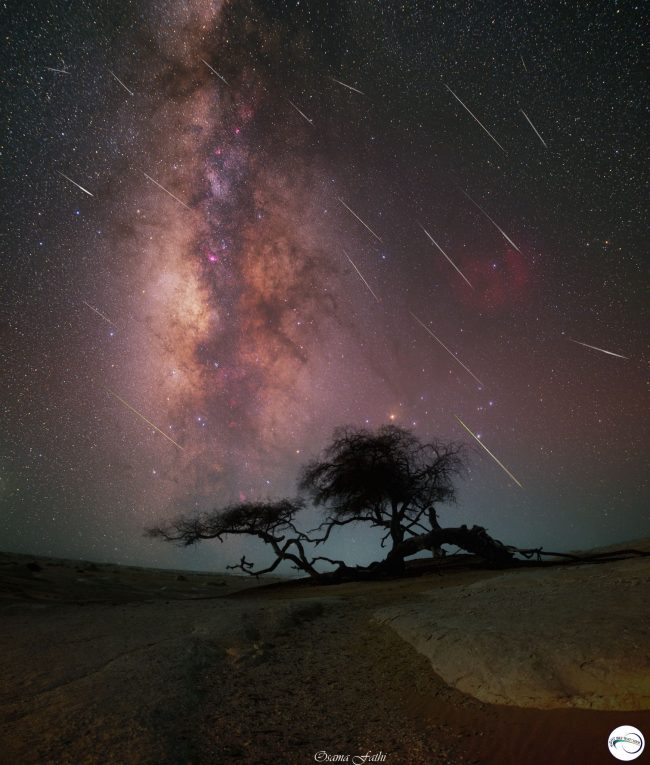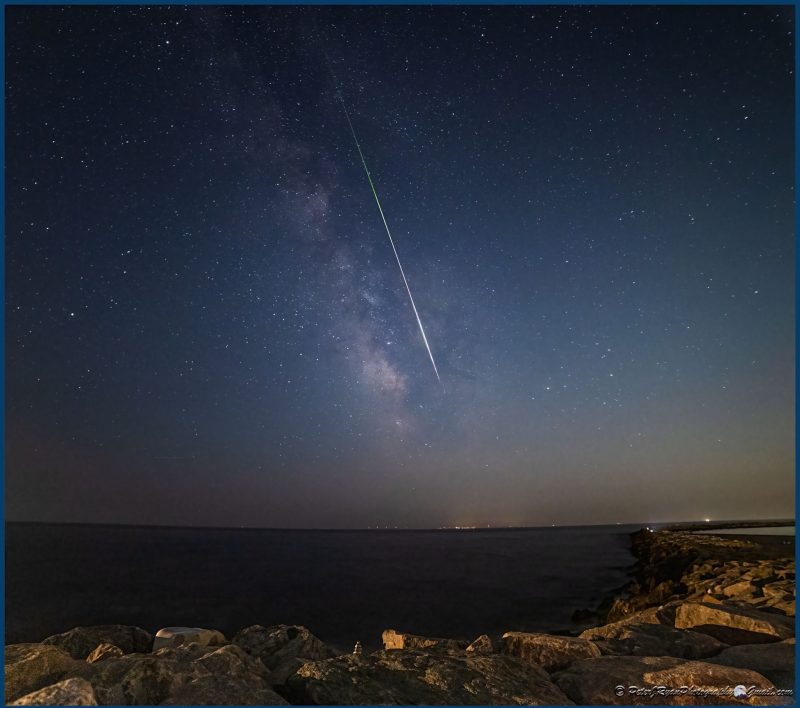
Perseid meteors will streak through Earth’s atmosphere starting in mid-July. A first quarter moon won’t interfere with the shower’s peak on the mornings of August 11, 12 and 13.
Early to mid-August meteors … the Perseids
Predicted peak: The peak is predicted** for August 12, 2024, at 14:00 UTC. So the mornings of August 11, 12 and 13 are probably your best bet.
When to watch: The moon will be a 1st quarter and 50% illuminated during 2024’s peak of the Perseid meteor shower. So the best time to watch for Perseids will be starting around midnight until dawn. This shower rises to a peak gradually, then falls off rapidly. And Perseid meteors tend to strengthen in number as late night deepens into the wee hours before dawn. The shower is often best just before dawn.
Radiant: The radiant rises in the middle of the night and is highest at dawn. See chart below.
Nearest moon phase: First quarter moon falls at 15:19 UTC on August 12. And a 1st quarter moon sets around midnight, so you’ll have dark skies after then until dawn.
Duration of shower: July 14 to September 1.
Expected meteors at peak, under ideal conditions: Under a dark sky with no moon, skywatchers frequently report 90 meteors per hour, or more.
Note: The August Perseid meteor shower is rich and steady, from early August through the peak. The meteors are colorful. And they frequently leave persistent trains. All of these factors make the Perseid shower perhaps the most beloved meteor shower for the Northern Hemisphere.
Report a fireball (very bright meteor) to the American Meteor Society: it’s fun and easy!
Perseid meteor shower radiant point
Around the peak mornings, if you trace all the Perseid meteors backward, they seem to come from the constellation Perseus near the famous Double Cluster. Hence, the meteor shower is named in honor of the constellation Perseus the Hero.
Of course, there’s no real connection between the meteor shower radiant and the constellation Perseus. The stars in Perseus are many light-years distant, while these meteors burn up about 60 miles (100 km) above the Earth’s surface.


The Perseids’ parent comet
From the late, great Don Machholz (1952-2022), who discovered 12 comets …
The parent comet responsible for the Perseid meteor shower is a rather large comet called 109P/Swift-Tuttle. The comet orbits the sun approximately every 133 years. Lewis Swift of Marathon, New York, visually discovered it on July 16, 1862, using an 11-centimeter (4.3-inch) refractor lens telescope. He did not report it immediately, believing that he was observing Comet Schmidt, which was found two weeks prior. Then, three days later, Horace Tuttle picked it up from Harvard Observatory. Scientists calculated that the comet would return in 120 years. That is, that we would see it again in 1982.
So, 1982 came and went. And the comet didn’t show up. Oops! It was back to the drawing board, and this time, the appearance of a comet observed in 1737 was considered a possible early appearance of the comet. Now, the orbital period was more like 130 years. Brian Marsden published new orbital elements and an ephemeris as to where to find it for its 1992 return.
In the 1980s, many of us visual comet hunters would, from time to time, cover the part of the sky where the incoming comet was supposed to appear. The 1991 outburst of Perseid meteors indicated that the comet was probably on its way back. Another meteor outburst in 1992 seemed to confirm that.
On September 26, 1992, Tsuruhiko Kiuchi, an amateur astronomer and comet hunter, picked up the comet in the evening sky just north of the bowl of the Big Dipper. Knowing where to look, I observed this comet 16 hours later and made a brightness estimate 5 times brighter than the original report. Others then confirmed this. Later, Gary Kronk suggested that the comets observed in 69 BCE and 188 CE were also appearances of this comet, a theory later confirmed.
Do Perseid meteors ever hit the ground?
Meteors that hit the ground intact are called meteorites. But few – if any – meteors in annual showers become meteorites. That’s primarily because of the flimsy nature of cometary debris. Comets are made of ices. Most meteorites, on the other hand, are the remains of rocky or metallic asteroids.
In ancient Greek star lore, Perseus is the son of the god Zeus and the mortal Danaë. It was said that the Perseid shower commemorates the time when Zeus visited Danaë, the mother of Perseus, in a shower of gold.
So think of the ephemeral nature of meteors in meteor showers, as you stand outside watching for Perseids in 2024. Most meteors strike Earth’s atmosphere unseen. You can consider any Perseid meteor you do see in 2024 as there for your viewing pleasure!
By the way, 2023 was a fantastic year for the Perseids: Enjoy this gallery of Perseid meteor photos from around the world, 2023.
A few Perseid meteor shower photos from EarthSky’s community



More Perseid meteor shower photos from EarthSky’s community


Bottom line: In 2024, the Perseid meteor shower peaks on the mornings of August 11, 12 and 13. Midnight to dawn is best! Be sure to watch in a dark sky.
**Predicted peak times and dates for 2024 meteor showers are from the American Meteor Society. Note that meteor shower peak times can vary.
EarthSky’s meteor shower guide











